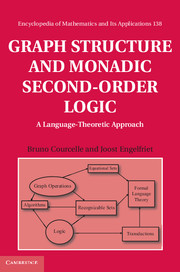Book contents
- Frontmatter
- Contents
- Foreword
- Introduction
- 1 Overview
- 2 Graph algebras and widths of graphs
- 3 Equational and recognizable sets in many-sorted algebras
- 4 Equational and recognizable sets of graphs
- 5 Monadic second-order logic
- 6 Algorithmic applications
- 7 Monadic second-order transductions
- 8 Transductions of terms and words
- 9 Relational structures
- Conclusion and open problems
- References
- Index of notation
- Index
5 - Monadic second-order logic
Published online by Cambridge University Press: 05 July 2012
- Frontmatter
- Contents
- Foreword
- Introduction
- 1 Overview
- 2 Graph algebras and widths of graphs
- 3 Equational and recognizable sets in many-sorted algebras
- 4 Equational and recognizable sets of graphs
- 5 Monadic second-order logic
- 6 Algorithmic applications
- 7 Monadic second-order transductions
- 8 Transductions of terms and words
- 9 Relational structures
- Conclusion and open problems
- References
- Index of notation
- Index
Summary
This chapter defines monadic second-order logic, and shows how it can be used to formalize the expression of graph properties. Monadic second-order formulas can also be used to express the properties of sets of vertices and/or edges in graphs. The Recognizability Theorem (Section 5.3.8) implies that a class of graphs characterized as the class of (finite) models of a monadic second-order sentence is VR-recognizable, and that it is HR-recognizable (but not necessarily VR-recognizable) if the sentence is written with edge set quantifications.
It follows that the monadic second-order satisfiability problem for the class of graphs of tree-width or of clique-width at most k is decidable for each k. Applications to the construction of fixed-parameter tractable algorithms and other algorithmic consequences will be developed in Chapter 6.
Although our first applications concern graphs, we will give the definitions and prove the main results for the general case of relational structures because proofs are not more difficult, and the corresponding results apply in a uniform manner to labeled graphs represented, in several ways, by binary relational structures. However, relational structures with n-ary relations for n ≥ 2 are actually interesting by themselves. As we have shown in Section 1.9, they are useful to formalize betweenness and cyclic ordering (and for relational databases).
In Sections 5.1 and 5.2, we review basic notions of logic, define monadic second-order logic, and give some results that delineate its expressive power.
- Type
- Chapter
- Information
- Graph Structure and Monadic Second-Order LogicA Language-Theoretic Approach, pp. 315 - 426Publisher: Cambridge University PressPrint publication year: 2012



